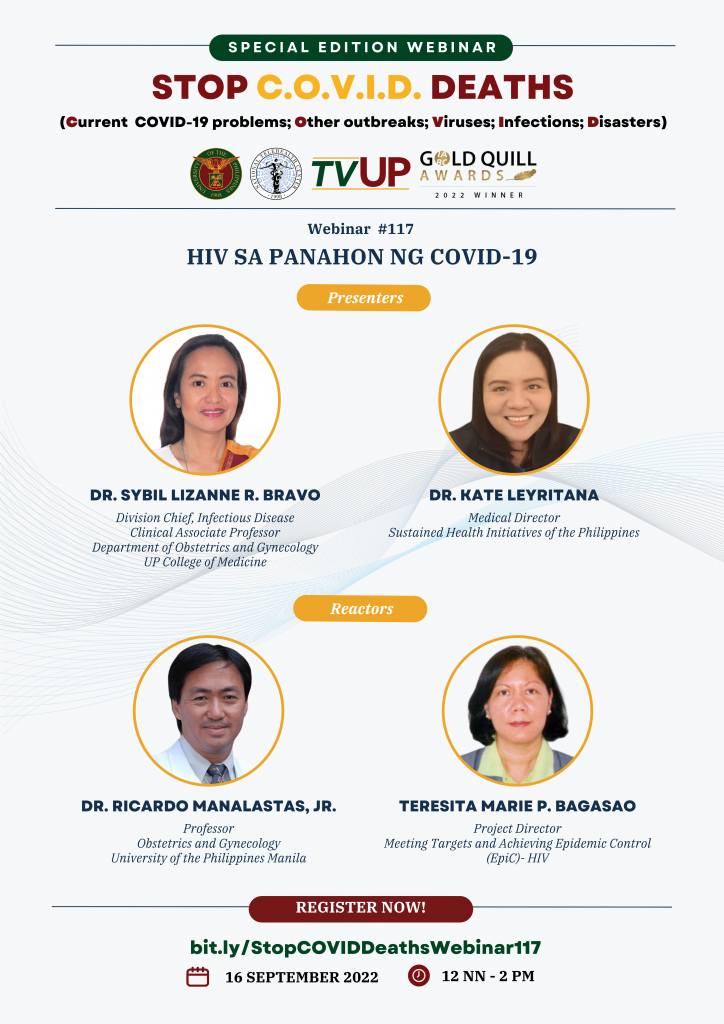
- This event has passed.
Stop COVID Deaths Webinar #117 “HIV sa Panahon ng COVID-19”

The University of the Philippines in partnership with
UP Manila NIH National Telehealth Center and in cooperation with
UP Philippine General Hospital
would like to invite you to join the Fight Against COVID-19!
Registration slots are limited to this SPECIAL EDITION of
the STOP C.O.V.I.D. DEATHS Webinar Series.
(Current COVID-19 problems; Other outbreaks; Viruses; Infections; Disasters)
So sign up NOW:
bit.ly/StopCOVIDDeathsWebinar117
Webinar #117
September 16, 2022 (Friday) 12nn
HIV sa Panahon ng COVID-19
Presenters:
Dr. Sybil Lizanne R. Bravo
Division Chief, Infectious Disease
Clinical Associate Prof., Dept of Obstetrics and Gynecology
UP College of Medicine
Dr. Kate Leyritana
Medical Director
Sustained Health Initiatives of the Philippines
Reactors:
Dr. Ricardo Manalastas, Jr.
Professor, Obstetrics and Gynecology
University of the Philippines Manila
Teresita Marie (Bai) P. Bagasao
Project Director, Meeting Targets and Achieving Epidemic Control (EpiC)- HIV
———————————————————–
Webinar #117
September 16, 2022
HIV sa Panahon ng COVID-19
When the first published report of what would ultimately become known as HIV and AIDS appeared in June 1981, very little was known about the disease. It did not have a name, it was not clear what caused it – there were no tests or treatment. Patients died within a few months.
The human immunodeficiency virus (HIV) targets the immune system and weakens people’s defense against many infections and some types of cancer.
The most advanced stage of HIV infection is acquired immunodeficiency syndrome (AIDS), which can take many years to develop if not treated, depending on the individual. AIDS is defined by the development of certain cancers, infections or other severe long-term clinical manifestations.
HIV is a major global public health issue, having claimed 40.1 million lives since 1981.
Prior to the COVID-19 pandemic, the Philippines had one of the highest rates of increase in HIV in this part of the world.
What happened during the pandemic? Did cases increase or decrease? Were HIV patients able to receive treatment and care during the lockdowns? These days, who are most at risk for HIV in the Philippines?
In this episode of STOP COVID DEATHS, we will take a closer look at an epidemic that occurred prior to and continued during the COVID-19 pandemic. This is a reminder and a wake-up call to invest in prevention and public education as well as services for other types of infections, not just COVID-19.
What should our frontline workers know about HIV and COVID-19? What kind of advice can be given to patients who are HIV positive? What is the status of treatment and drugs and medicines? How are young people being continuously engaged in prevention?
Our experts include: Dr. Sybil Lizanne R. Bravo, Division Chief of Infectious Disease and Clinical Associate Professor with the Dept of Obstetrics and Gynecology at the UP College of Medicine; and Dr. Kate Leyritana, Medical Director of the Sustained Health Initiatives of the Philippines. Our reactors include: Dr. Ricardo Manalastas, Jr., Professor of Obstetrics and Gynecology at the University of the Philippines Manila; and Teresita Marie P. Bagasao, Project Director of Meeting Targets and Achieving Epidemic Control (EpiC)- HIV.
We will also feature the most recent information on HIV, prevention, treatment and new literature. We will talk about who is at risk and will also view materials from a recent media campaign.
Join us as we learn more about infections!
Together, we can STOP C.O.V.I.D. DEATHS!
